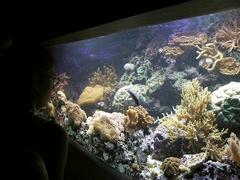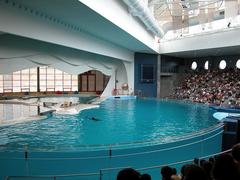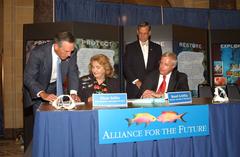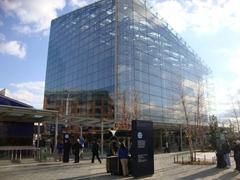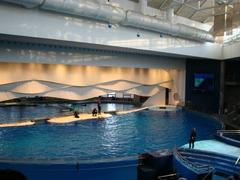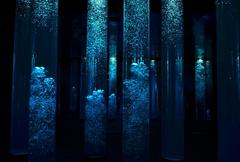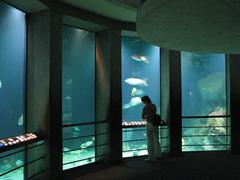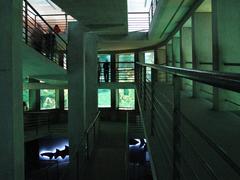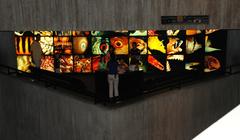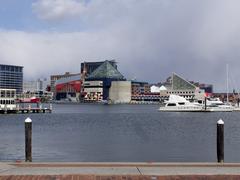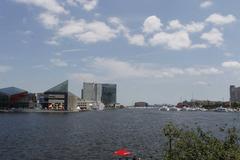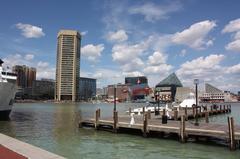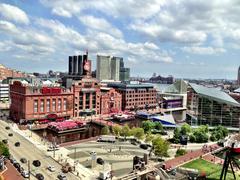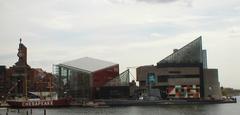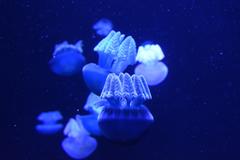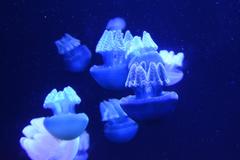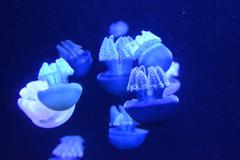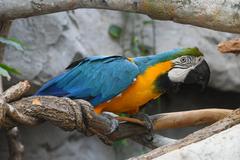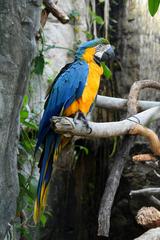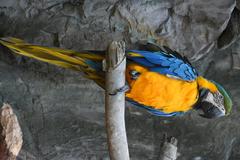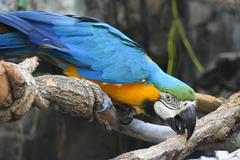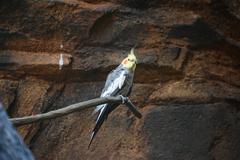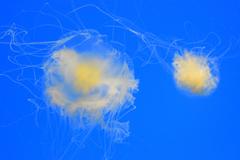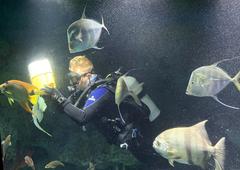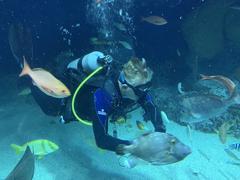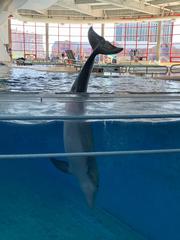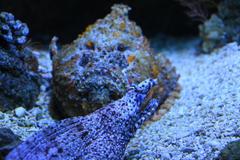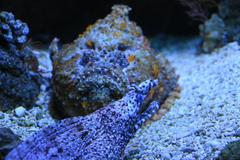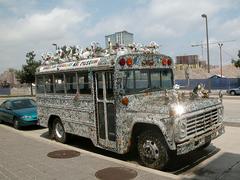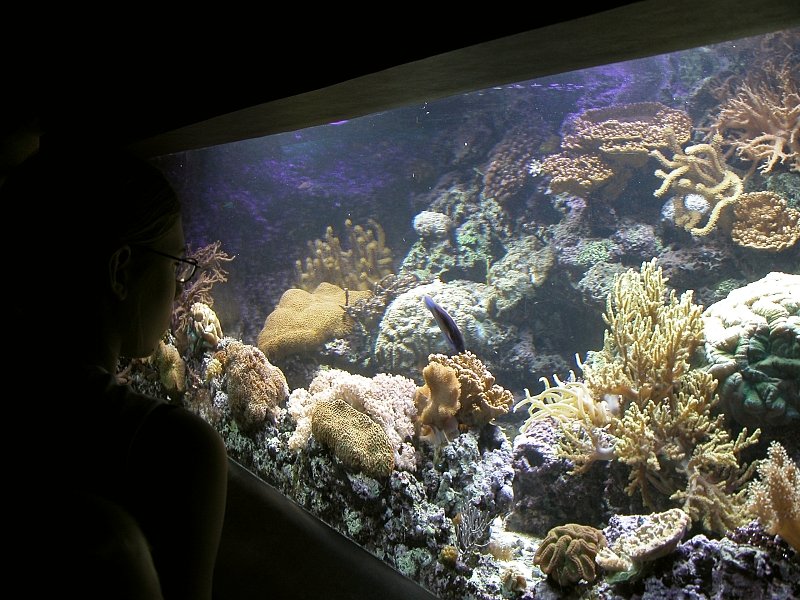
National Aquarium in Baltimore Visiting Guide
Date: 17/07/2024
Introduction
Nestled in the vibrant Inner Harbor of Baltimore, the National Aquarium is a beacon of marine conservation, education, and immersive experiences. Since its inception, this iconic institution has drawn millions of visitors, offering a gateway to the wonders of aquatic ecosystems from around the globe. The story of the National Aquarium is one of transformation, beginning in the 1960s when Baltimore city officials envisioned an aquarium as a cornerstone for urban renewal (National Aquarium). By 1981, with the support of a significant grant from the United States Department of Housing and Urban Development (HUD), the dream became a reality, marked by the opening of the architectural marvel on Pier 3 with its distinctive pyramidal glass roof (History). Today, the National Aquarium stands as a testament to the power of vision and collaboration, continually evolving to prioritize animal welfare, promote conservation, and inspire future generations. With over 20,000 animals representing more than 750 species, it offers an unforgettable journey through diverse habitats, from the rainforests of the Amazon to the depths of the Atlantic Coral Reef. Join us as we explore the rich history, captivating exhibits, and practical visitor information that make the National Aquarium in Baltimore a must-visit destination.
Table of Contents
- [A Legacy on the Inner Harbor - The National Aquarium’s Story](#a-legacy-on-the-inner-harbor---the-national-aquariums-storya-legacy-on-the-inner-harbor---the-national-aquariums-story)
- [The Spark of an Idea](#the-spark-of-an-ideathe-spark-of-an-idea)
- [From Vision to Reality](#from-vision-to-realityfrom-vision-to-reality)
- [Opening Doors and Making Waves](#opening-doors-and-making-wavesopening-doors-and-making-waves)
- [Expansion and Evolution](#expansion-and-evolutionexpansion-and-evolution)
- [A Focus on Animal Welfare](#a-focus-on-animal-welfarea-focus-on-animal-welfare)
- [A Continued Commitment to Conservation](#a-continued-commitment-to-conservationa-continued-commitment-to-conservation)
- [Beyond the Tanks - A Legacy of Impact](#beyond-the-tanks---a-legacy-of-impactbeyond-the-tanks---a-legacy-of-impact)
- [Visitor Information](#visitor-informationvisitor-information)
- [Visiting Hours](#visiting-hoursvisiting-hours)
- [Tickets](#ticketstickets)
- [Special Events and Guided Tours](#special-events-and-guided-toursspecial-events-and-guided-tours)
- [Nearby Attractions and Travel Tips](#nearby-attractions-and-travel-tipsnearby-attractions-and-travel-tips)
- [Accessibility](#accessibilityaccessibility)
- [Explore the National Aquarium in Baltimore - Exhibits, Tickets, and Visitor Tips](#explore-the-national-aquarium-in-baltimore---exhibits-tickets-and-visitor-tipsexplore-the-national-aquarium-in-baltimore---exhibits-tickets-and-visitor-tips)
- [Main Exhibits and Marine Life](#main-exhibits-and-marine-lifemain-exhibits-and-marine-life)
- [Upland Tropical Rain Forest](#upland-tropical-rain-forestupland-tropical-rain-forest)
- [Atlantic Coral Reef](#atlantic-coral-reefatlantic-coral-reef)
- [Blacktip Reef](#blacktip-reefblacktip-reef)
- [Jellies Invasion](#jellies-invasionjellies-invasion)
- [Living Treasures of the Amazon](#living-treasures-of-the-amazonliving-treasures-of-the-amazon)
- [Australia - Wild Extremes](#australia---wild-extremesaustralia---wild-extremes)
- [Dolphin Discovery](#dolphin-discoverydolphin-discovery)
- [Maryland - Mountains to the Sea](#maryland---mountains-to-the-seamaryland---mountains-to-the-sea)
- [Surviving Sharks](#surviving-sharkssurviving-sharks)
- [Animal Care and Rescue](#animal-care-and-rescueanimal-care-and-rescue)
- [Visitor Tips](#visitor-tipsvisitor-tips)
- [Nearby Attractions and Historical Sites](#nearby-attractions-and-historical-sitesnearby-attractions-and-historical-sites)
- [Frequently Asked Questions (FAQ)](#frequently-asked-questions-faqfrequently-asked-questions-faq)
- [Main Exhibits and Marine Life](#main-exhibits-and-marine-lifemain-exhibits-and-marine-life)
- [Plan Your Visit to the National Aquarium in Baltimore - Hours, Tickets, and Tips](#plan-your-visit-to-the-national-aquarium-in-baltimore---hours-tickets-and-tipsplan-your-visit-to-the-national-aquarium-in-baltimore---hours-tickets-and-tips)
- [Planning Your Visit](#planning-your-visitplanning-your-visit)
- [Location and Contact](#location-and-contactlocation-and-contact)
- [Hours of Operation](#hours-of-operationhours-of-operation)
- [Ticket Prices and Purchase](#ticket-prices-and-purchaseticket-prices-and-purchase)
- [Getting There](#getting-theregetting-there)
- [Planning Your Visit](#planning-your-visitplanning-your-visit)
- [Conclusion](#conclusionconclusion)
- [References and Further Reading](#references-and-further-readingreferences-and-further-reading)
A Legacy on the Inner Harbor - The National Aquarium’s Story
The National Aquarium’s story is one of evolution, mirroring the revitalization of Baltimore’s Inner Harbor. What began as a vision for urban renewal blossomed into a world-renowned aquatic conservation and education center.
The Spark of an Idea
The idea for a Baltimore aquarium first surfaced in the 1960s. The city, like many urban centers at the time, grappled with a declining industrial core and a waterfront in need of revitalization. Inspired by the success of other cities using public aquariums as cornerstones for urban renewal, Baltimore city officials saw an opportunity.
From Vision to Reality
In 1976, the City of Baltimore secured an $11.5 million grant from the United States Department of Housing and Urban Development (HUD) to construct a world-class aquarium. This funding was instrumental in transforming the vision into a tangible project.
Opening Doors and Making Waves
On August 8, 1981, the National Aquarium, Baltimore, opened its doors to the public. The initial building, now known as Pier 3, was an architectural marvel with its iconic pyramidal glass roof designed by Peter Chermayeff of Cambridge Seven Associates. The aquarium’s arrival marked a turning point for the Inner Harbor, drawing visitors and breathing new life into the area.
Expansion and Evolution
The National Aquarium’s commitment to conservation and education fueled its growth. In 1990, a $35 million expansion added the Marine Mammal Pavilion, featuring a dramatic 1,300,000-gallon Atlantic Coral Reef exhibit. This expansion solidified the aquarium’s position as a leader in marine life care and display.
A Focus on Animal Welfare
The late 1990s and early 2000s saw a shift in the aquarium world towards animal welfare and conservation. The National Aquarium embraced this change, phasing out dolphin shows in 2012 and announcing plans to create a more natural, seaside sanctuary for its beloved dolphins. This decision reflected the aquarium’s evolving understanding of animal needs and its commitment to ethical practices.
A Continued Commitment to Conservation
Today, the National Aquarium stands as a beacon of conservation, research, and education. With over 20,000 animals representing more than 750 species, the aquarium offers visitors an immersive journey through diverse aquatic ecosystems. From the rainforests of the Amazon to the depths of the Atlantic Coral Reef, each exhibit highlights the interconnectedness of life on Earth and the importance of protecting our planet’s precious resources.
Beyond the Tanks - A Legacy of Impact
The National Aquarium’s impact extends far beyond its walls. Through its conservation efforts, the aquarium actively participates in research, rescue, and rehabilitation programs worldwide. The institution’s commitment to education is evident in its diverse range of programs, inspiring future generations to become stewards of the environment.
The National Aquarium’s story is a testament to the power of vision, collaboration, and a deep respect for the natural world. As the aquarium continues to evolve, its commitment to conservation, education, and creating unforgettable experiences for visitors remains unwavering.
Visitor Information
Visiting Hours
The National Aquarium is open daily from 9:00 AM to 5:00 PM, with extended hours on weekends and holidays. It’s advisable to check the official website for any changes in visiting hours due to special events or seasonal variations.
Tickets
Ticket prices vary based on age and membership status. General admission for adults is $39.95, seniors (65+) are $34.95, children (3-11) are $29.95, and children under 3 are free. Members enjoy free admission and additional benefits. Tickets can be purchased online or at the aquarium’s ticket counter.
Special Events and Guided Tours
The National Aquarium hosts a variety of special events throughout the year, including behind-the-scenes tours, sleepovers, and educational workshops. Guided tours are available for those who want an in-depth experience and to learn more about the exhibits and conservation efforts.
Nearby Attractions and Travel Tips
Located in the vibrant Inner Harbor area, the National Aquarium is surrounded by historical sites, restaurants, and shopping centers. Nearby attractions include the Maryland Science Center, Historic Ships in Baltimore, and the American Visionary Art Museum. Public transportation, parking garages, and bike rentals are available for convenient access to the area.
Accessibility
The National Aquarium is committed to providing an inclusive experience for all visitors. The facility is wheelchair accessible, and services such as sensory bags, ASL interpreters, and captioning devices are available upon request. More information on accessibility can be found on the aquarium’s official website.
Explore the National Aquarium in Baltimore - Exhibits, Tickets, and Visitor Tips
Main Exhibits and Marine Life
The National Aquarium is divided into several themed exhibits, each showcasing unique aquatic ecosystems and their inhabitants.
Upland Tropical Rain Forest
Journey Above the Water: This exhibit replicates the sights and sounds of a tropical rain forest. Visitors can explore the canopy level, home to brightly colored poison dart frogs and exotic birds, before descending to the forest floor, where they’ll encounter a cascading waterfall and diverse fish species.
Atlantic Coral Reef
A Dazzling Display of Life: This massive, 335,000-gallon exhibit is the centerpiece of the aquarium. Modeled after an Indo-Pacific reef, it teems with life, including colorful fish, graceful rays, and majestic sea turtles. Visitors can observe the symbiotic relationships between various species and learn about the importance of coral reef conservation.
Blacktip Reef
Sharks and More: This exhibit transports visitors to an Indo-Pacific reef, home to blacktip reef sharks, zebra sharks, and a rescued green sea turtle named Calypso. The exhibit features a large viewing window that offers an immersive underwater perspective.
Jellies Invasion
Hypnotic Beauty: This exhibit showcases the ethereal beauty of jellyfish. Visitors can marvel at the pulsating movements of moon jellies, the intricate patterns of Pacific sea nettles, and the vibrant colors of flower hat jellies.
Living Treasures of the Amazon
Diversity of the Amazon Basin: This exhibit highlights the incredible biodiversity of the Amazon River basin. Visitors can encounter piranhas, freshwater stingrays, and the iconic arapaima, one of the largest freshwater fish in the world.
Australia - Wild Extremes
Unique Species from Down Under: This exhibit showcases the diverse wildlife of Australia, both aquatic and terrestrial. Visitors can encounter grey-headed flying foxes, laughing kookaburras, and a variety of venomous snakes. The exhibit also features a touch pool where visitors can interact with sea stars and other marine invertebrates.
Dolphin Discovery
Playful and Intelligent Creatures: This exhibit is home to a pod of Atlantic bottlenose dolphins. Visitors can watch these highly intelligent animals interact with their trainers during daily shows and learn about dolphin behavior and conservation efforts.
Maryland - Mountains to the Sea
Local Aquatic Life: This exhibit highlights the diverse aquatic ecosystems found in Maryland, from the Appalachian Mountains to the Chesapeake Bay. Visitors can encounter brook trout, American eels, and diamondback terrapins, a species of turtle native to the Chesapeake Bay.
Surviving Sharks
Dispelling Myths, Promoting Conservation: This exhibit aims to dispel myths and promote conservation of these often-misunderstood creatures. Visitors can learn about the important role sharks play in maintaining healthy ocean ecosystems and observe various shark species, including sand tiger sharks and nurse sharks.
Animal Care and Rescue
Behind the Scenes: The National Aquarium is deeply committed to animal care and rescue. Visitors can learn about the aquarium’s efforts to rehabilitate and release injured marine animals, as well as its work to conserve endangered species.
Visitor Tips
- Plan Your Visit: The National Aquarium is a popular attraction, so it’s recommended to purchase tickets online in advance, especially during peak season. For more information on visiting hours and ticket prices, visit the official National Aquarium website.
- Allow Ample Time: To fully experience all the exhibits, allow at least 2-3 hours for your visit.
- Engage with Staff: The aquarium staff is knowledgeable and passionate about marine life. Don’t hesitate to ask questions and learn more about the animals and exhibits.
- Attend a Show or Program: The aquarium offers various shows and programs throughout the day, providing opportunities to learn more about specific animals or conservation efforts.
- Dining Options: The aquarium has a café and a restaurant offering a variety of food and beverage options.
- Accessibility: The National Aquarium is fully accessible to visitors with disabilities. Wheelchairs are available for rent, and assistive listening devices are available upon request.
Nearby Attractions and Historical Sites
- Baltimore Inner Harbor: Just steps away from the aquarium, the Inner Harbor offers shopping, dining, and a variety of entertainment options.
- Fort McHenry National Monument: A short drive from the aquarium, this historical site is where the Star-Spangled Banner was written during the War of 1812.
- Maryland Science Center: Located nearby, this center offers interactive exhibits and an IMAX theater, perfect for a family outing.
Frequently Asked Questions (FAQ)
- What are the National Aquarium’s visiting hours? Visiting hours vary by season and day of the week. For the most up-to-date information, check the National Aquarium’s visiting hours page.
- How much are tickets to the National Aquarium? Ticket prices vary based on age and membership status. For detailed pricing, visit the National Aquarium tickets page.
- Are there guided tours available? Yes, the National Aquarium offers a variety of guided tours and special programs. Check the Guided Tours page for more information.
- Is photography allowed in the aquarium? Yes, photography is allowed for personal use, but flash photography is prohibited to protect the animals.
Plan Your Visit to the National Aquarium in Baltimore - Hours, Tickets, and Tips
Planning Your Visit
- Location and Contact: The National Aquarium is located at 501 E Pratt St, Baltimore, MD 21202. You can reach them at (410) 576-3800 or through their website (National Aquarium).
- Hours of Operation: The Aquarium is open daily from 9:00 AM to 5:00 PM. However, it’s always best to check the official website for the most up-to-date hours, especially during holidays and peak seasons.
- Ticket Prices and Purchase: Admission prices vary depending on age and residency. You can find detailed pricing information on the Aquarium’s website. It’s highly recommended to purchase tickets online in advance, especially during peak season, to secure your spot and avoid long lines.
- Getting There: The Aquarium is easily accessible by public transportation. The closest Light Rail stop is Camden Yards, and several bus routes also serve the area.
Conclusion
The National Aquarium in Baltimore remains a shining example of how urban renewal, conservation, and education can harmoniously converge. Its storied history, marked by visionary leadership and community support, has transformed it into a world-renowned institution dedicated to the care and display of marine life. The aquarium’s commitment to ethical practices and conservation is evident in its phasing out of dolphin shows and ongoing efforts to establish a natural seaside sanctuary for its dolphins (Conservation Efforts). Visitors are treated to an educational and awe-inspiring journey through meticulously designed exhibits that highlight the interconnectedness of aquatic ecosystems and the importance of preserving our planet’s natural resources. Whether you’re drawn to the hypnotic movements of jellyfish, the vibrant life of coral reefs, or the playful antics of dolphins, the National Aquarium offers something for everyone. Beyond its walls, the aquarium’s impact is felt through its global conservation initiatives and educational programs that inspire environmental stewardship. Plan your visit today and become part of a legacy that celebrates and protects the wonders of the natural world. For the latest updates and information, follow the National Aquarium on their social media or download their mobile app.
References and Further Reading
- National Aquarium. (n.d.). Retrieved from https://aqua.org
- History. (n.d.). National Aquarium. Retrieved from https://aqua.org/about/history
- Conservation Efforts. (n.d.). National Aquarium. Retrieved from https://aqua.org/conservation
- Social Media. (n.d.). National Aquarium. Retrieved from https://aqua.org/about/contact/social-media
